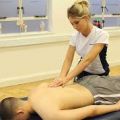What to Know About Foot Changes After Walking Barefoot

The COVID-19 pandemic altered many aspects of people's lives, from socializing to grocery shopping. Many people's jobs were affected by the COVID-19 pandemic.
You most likely worked from home at some point if your job allowed it. Perhaps you work from home, or at least on a part-time basis. Perhaps your company has gone completely remote, and you will never have to come into the office again.
Healthcare providers reported seeing foot changes in people who walked barefoot while working from home during the COVID-19 pandemic. Here's what you should know about how barefoot walking can affect your feet and what you can do about it.
What Causes Foot Changes?
Normal aging causes your foot ligaments to stretch and your tendons to degenerate. When you put stress on your feet, the wear-and-tear process accelerates. Wearing unsupportive shoes, for example, puts strain on your feet.
You may have had foot problems prior to the COVID-19 pandemic that you managed by wearing shoes and orthotics on a regular basis. However, without those supportive structures, your foot issues may have become more severe than before. Walking around barefoot on hardwood floors and tiles can also aggravate pre-existing foot problems. Your activity level is another reason for a change in your feet during the COVID-19 pandemic.
Are Foot Changes Reversible?
The reversibility of foot changes is determined by whether the change is flexible or rigid. Physical therapy can typically help strengthen the foot and restore arch strength and height if the change is flexible. Rigid changes, on the other hand, are stiff and immobile. Surgery can help correct rigid changes in some cases.
A bunion, for example, is a bony growth caused by hallux abducto valgus (HAV). HAV develops after prolonged contact with the joints of your big toe. A bunion develops when a joint becomes misaligned. While physical therapy can help with HAV, the bony growth is a permanent change.
Should You Wear Shoes Around the House?
You're not walking around any less if you work from home instead of in an office. In fact, you're probably walking around your house more than you realize.
However, working from home does not imply that you must always wear something on your feet. Instead, keep track of when your activity levels peak during the day and wear shoes during that time.
It's perfectly acceptable to remove your shoes at the end of the workday if you haven't been active. However, wearing "anything is better than nothing" is especially appropriate during the workday.
At-Home Footwear
In general, a shoe that feels comfortable, supportive, and sturdy is best for most people. A supportive house slipper or a thick-cushioned sandal will suffice.
If you work from home and must stand all day, consider wearing a supportive, shock-absorbing shoe. Also, if you'd normally wear orthotic inserts in your office shoes, consider trying them out. However, at home, you can put the inserts into something less formal, such as a running shoe.
Maybe you went barefoot at home and didn't notice any changes or pain in your feet. If you prefer to walk barefoot, you can most likely continue to do so.
Other Things To Remember About Foot Changes
Some people, on the other hand, may have had previous foot problems that were resolved during the COVID-19 pandemic. Work shoes, for some, are tighter, less comfortable, and less supportive than any casual shoe.
In fact, gradually transitioning to barefoot walking may improve the health of your feet. Bunions, hammer toes, blisters, corns, and neuromas are all caused by footwear.
Bunions can be caused by wearing shoes that are too small. Barefoot walking, on the other hand, can help strengthen your foot muscles. Walking barefoot also allows your feet and toes to return to their natural positions.
Examine the shoes you wore to work before switching to working from home and make a note of the changes you require in a shoe.
For some, this may imply finding wider shoes. Someone else may need to look for a shoe with a thicker sole. Surprisingly, a slight heel can sometimes help their foot problem.
Other articles and publications:
Articles and publications of other companies:
- +1 (646) 270-9836
- Long Island City
- grantny.com













